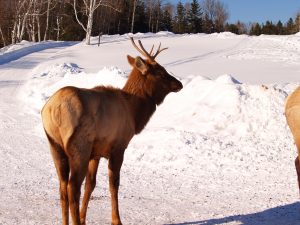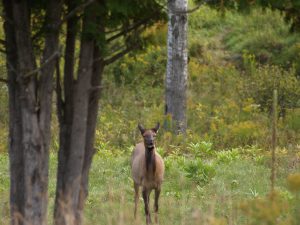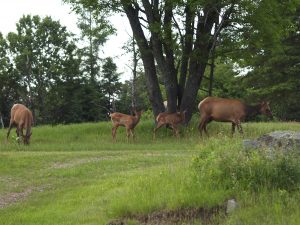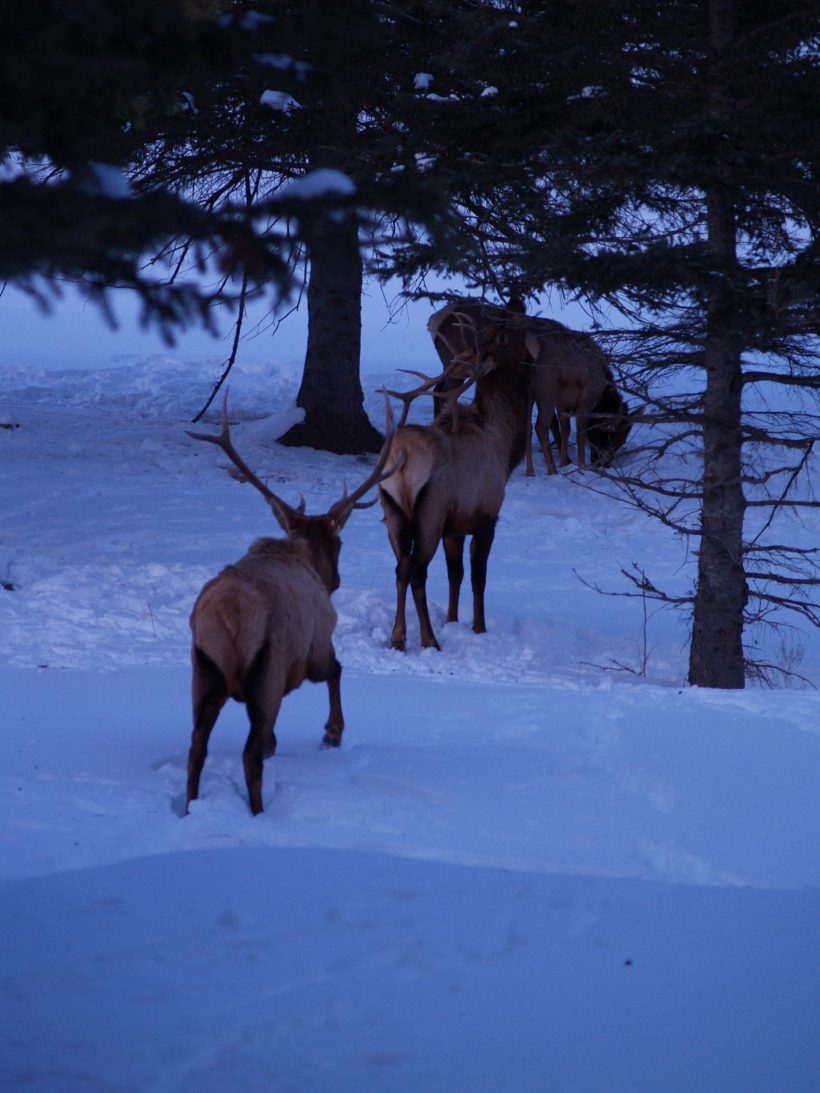Birth of an Elk
Time travellers have recorded the presence of elk on earth over 120,000 years ago. During the glacial age there weren’t a lot of elk in North America. However as the glaciers absorbed water from the oceans of the world a land bridge emerged between Siberia and Alaska providing a passage from Eurasia to North America over which theory has it many migrated not the least of which was the red deer, ancestor to the North American elk.
As the earth warmed and the glaciers retreated the elk began to migrate from Alaska in a southward and eastward direction. Over many years the elk adapted to whatever geographical area they inhabited. The European invasion of North America discovered at least six different kinds of elk. The Merriam’s elk lived in the southwest and Mexico; the Eastern elk lived throughout the eastern United States; Tule elk inhabited California; Manitoban elk spread out over the Great Plains into Canada; Roosevelt’s elk stayed near the Oregon and Washington coasts; and the Rocky Mountain elk were found throughout the Rocky Mountains.
As the Europeans expanded westward they killed many elk for food, to eliminate them as competition for their crops and livestock, and destroyed habitat for settlement. By the 1900s, two subspecies, the Merriam’s and the Eastern had gone the way of the Dodo bird and the other four were near extinction.
From a population low of perhaps 90,000 in the early 1900s the elk herds have grown throughout North America to approach some one million animals today with the help of hunters and other conservationists. One million represents about 10% of their estimated population before the Europeans arrived. Today there are wild elk in five Canadian provinces and 24 American states. Readers may have heard the elk referred to as Wapiti (wap-i-tee) which is Shawnee Indian for elk meaning “white rump.” Conflicts and wildlife management challenges continue to arise as ever expanding human populations ever continue to invade elk habitat. The elk lose important feeding habitat to “civilization” and people complain when the elk eat their hay, crops, gardens and shrubs.
A Brief Biology
The cow elk will weigh as much as 500 pounds (225 kg), stand 4 ½ feet (1.3m) at the shoulder and measure 6 ½ feet (2m) from tip of the nose to the tip of the tail. A bull can weigh 700 pounds (315 kg), stand 5 feet (1.5m) at the shoulder and measure 8 feet (2.4m) nose to tail. A newborn calf can weigh 35 pounds (16 kg). The elk are also members of the deer family as are moose, white-tail deer, caribou and mule deer. The body colour varies from a deep copper brown to light tan depending upon the season and location; the rump patch is light beige and the legs and neck often are darker than the body. Antlers can weigh up to 40 pounds (18 kg) a pair. The bulls grow them to display dominance, to joust with other bulls and occasionally for defense.

Elk can bark, squeal, and bugle. They also, like people, communicate via their body language or posture and scent. Although I leave the people scent part to you the reader to imagine.
The elk rut or breeding season is in the fall or autumn, September/October and gestation lasts 8 ½ months. Depending on the location birthing occurs sometime in mid-May to early July, normally.
Socially cows, calves and yearlings live in loose herds or groups while bulls pull the bachelor thing and either live in groups or alone. “Harems” are made up of cows and calves usually associated with one or two mature bulls. Yearling bulls may form bachelor groups or stay near the harems.
Elk habitat requirements match anyone’s – food, water, shelter and space. Imagine how well you would do without those 4 ingredients. Elk live in a variety of habitat that includes coastal forests, alpine meadows, desert valleys and snowy mountain ridges. The food varies with season, location and availability including grasses, woody plants (winter); grasses (spring/fall); grass and forbs (low-growing soft-stemmed plants) in summer.
Elk predators include people, bear, wolves, coyotes and cougars.
Immediately following birth the elk calf goes into hiding. The cow hides the calf in tall thick grass, in the bush, behind a log…The camouflaging white spots and minimum of scent help to protect the calf from nosy predators. The cow will stand guard from a “safe distance” and only approach 4-6 times daily in order to nurse her calf. The cow can rush predators using her dangerous front hooves as weapons. She will try to decoy the bigger predators such as wolves, bears…away from the hiding calf. Within a couple of weeks the calves will develop enough strength and agility to run, play and keep up with their mothers. At this point, the cow and calf will join the herd.
Late Born
Because he feeds the elk Joe Neuhold has the advantage of seeing them on a daily basis. The powers of observation play an important role in the learning process. On October 5, 2004, Neuhold photographed a recently born male elk. As mentioned early, this was not the norm. The following is an account from the case study of this calf that was written by Dr. Rick Rosatte of the MNR.
Rosatte calculated that the calf was conceived between late December 2003 and early January 2004. As mentioned most calves are born between late May and early June with conception taking place in September/October. This allows for an optimum growth period for calves to take place before winter and thus increases its chances of survival. The late calf was born to an 11 year old cow. Her age and inability to meet the annual energy requirements necessary for normal reproduction may have contributed to the late conception and birth dates.

The late spotted calf was estimated to be about 3 weeks old and based on his body size weighed about 25-30 kg. Neuhold observed the calf nursing on November 1, 2004, from an 11-year-old cow elk ear tagged #347. She had been released in the Bancroft/North Hastings area during April 2001. The calf was observed nursing from the cow during December 2004 and January 2005. Still sporting his spots, the calf was photographed on February 1, 2005, near Hartsmere. It accompanied a group of 38 elk- 13 bulls, 8 calves and 17 cows including the calf’s mother. The late calf was about 25%-35% smaller than the other calves that were born during early spring and summer.
Unfortunately, the spotted calf was killed on February 25, 2005. Evidence in the fresh snow – tracks, injuries to the calf, and blood on the antlers of a mature bull elk – indicated that the calf was likely gored to death.
Studies indicate that elk reproductive success generally declines after 7 years of age. One adaptive strategy of elk is the production of highly developed, rapid growing, large young in order that the calves can quickly reach a size that maximizes winter survival. Maternal milk provides the high energy requirement for rapid growth. Elk calves acquire most of their nutritional requirements during the first month of life from milk. Subsequently, greater requirements require solid forage as in the early spring/summer (late May/early June) when the forage is high in protein and nutrition. The timing for elk calving is such that inclement winter/spring weather is avoided but it is early enough so the calves can attain sufficient weight and size to survive winter.
Juvenile elk have evolved to reduce or cease growth during the fall and winter when the nutritive value of the forage declines. A study by Cook in 1996 indicated that Calf growth in mid-November is apparently 50% of that in September and hypothesized that the nutritional strategy of elk calves during late fall/early winter was primarily to maintain condition rather than maximize growth. Inevitably, energy acquisition for rapid growth becomes a problem for late-born calves, due to a combination of less nutritious forage and a decline in milk production in lactating cow elk due to poor quality forage. Survival among late-born elk calves in Yellowstone National Park was lower than earlier-born calves. Calf mortality appeared to be primarily due to malnutrition.

The calf in this study was observed nursing in mid-January 2005 and supplemental feeding by people in the area may have provided sufficient energy for the cow to continue milk production during the winter. Generally, reproductive success for 11 year old elk is low. The age of the cow in this study and her inability to meet the annual energy requirements necessary for normal reproduction may have contributed to the late conception and birth dates. The late born elk calf with spots was about 25% smaller than other calves when photographed near Hartsmere, Ontario, 1 February 2005.
